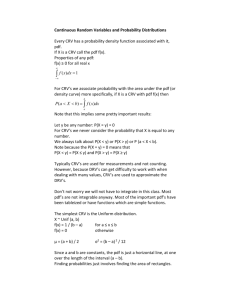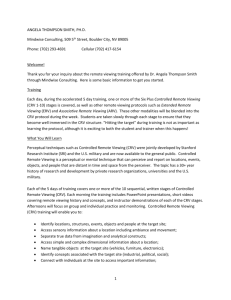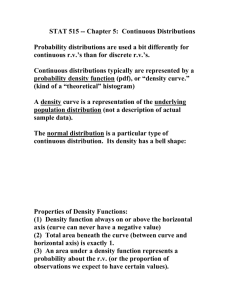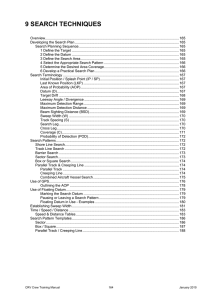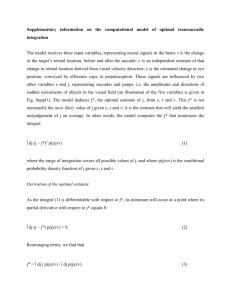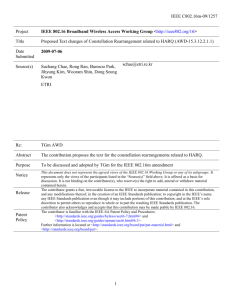C1 – Coordinate Geometry Summary
advertisement
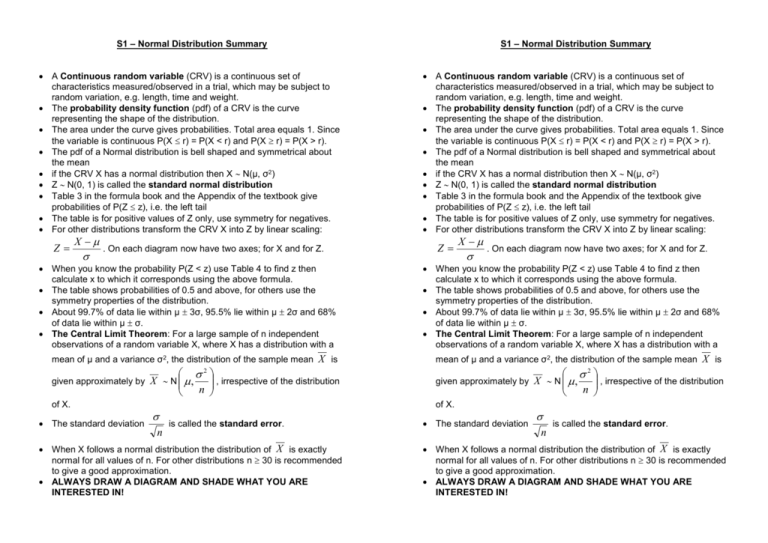
S1 – Normal Distribution Summary S1 – Normal Distribution Summary A Continuous random variable (CRV) is a continuous set of characteristics measured/observed in a trial, which may be subject to random variation, e.g. length, time and weight. The probability density function (pdf) of a CRV is the curve representing the shape of the distribution. The area under the curve gives probabilities. Total area equals 1. Since the variable is continuous P(X r) = P(X < r) and P(X r) = P(X > r). The pdf of a Normal distribution is bell shaped and symmetrical about the mean if the CRV X has a normal distribution then X N(μ, σ2) Z N(0, 1) is called the standard normal distribution Table 3 in the formula book and the Appendix of the textbook give probabilities of P(Z z), i.e. the left tail The table is for positive values of Z only, use symmetry for negatives. For other distributions transform the CRV X into Z by linear scaling: A Continuous random variable (CRV) is a continuous set of characteristics measured/observed in a trial, which may be subject to random variation, e.g. length, time and weight. The probability density function (pdf) of a CRV is the curve representing the shape of the distribution. The area under the curve gives probabilities. Total area equals 1. Since the variable is continuous P(X r) = P(X < r) and P(X r) = P(X > r). The pdf of a Normal distribution is bell shaped and symmetrical about the mean if the CRV X has a normal distribution then X N(μ, σ2) Z N(0, 1) is called the standard normal distribution Table 3 in the formula book and the Appendix of the textbook give probabilities of P(Z z), i.e. the left tail The table is for positive values of Z only, use symmetry for negatives. For other distributions transform the CRV X into Z by linear scaling: Z X . On each diagram now have two axes; for X and for Z. Z X . On each diagram now have two axes; for X and for Z. When you know the probability P(Z < z) use Table 4 to find z then calculate x to which it corresponds using the above formula. The table shows probabilities of 0.5 and above, for others use the symmetry properties of the distribution. About 99.7% of data lie within μ 3σ, 95.5% lie within μ 2σ and 68% of data lie within μ σ. The Central Limit Theorem: For a large sample of n independent observations of a random variable X, where X has a distribution with a When you know the probability P(Z < z) use Table 4 to find z then calculate x to which it corresponds using the above formula. The table shows probabilities of 0.5 and above, for others use the symmetry properties of the distribution. About 99.7% of data lie within μ 3σ, 95.5% lie within μ 2σ and 68% of data lie within μ σ. The Central Limit Theorem: For a large sample of n independent observations of a random variable X, where X has a distribution with a mean of μ and a variance σ2, the distribution of the sample mean X is mean of μ and a variance σ2, the distribution of the sample mean X is given approximately by X N , of X. The standard deviation n 2 , irrespective of the distribution n given approximately by X N , of X. is called the standard error. When X follows a normal distribution the distribution of X is exactly normal for all values of n. For other distributions n 30 is recommended to give a good approximation. ALWAYS DRAW A DIAGRAM AND SHADE WHAT YOU ARE INTERESTED IN! The standard deviation n 2 , irrespective of the distribution n is called the standard error. When X follows a normal distribution the distribution of X is exactly normal for all values of n. For other distributions n 30 is recommended to give a good approximation. ALWAYS DRAW A DIAGRAM AND SHADE WHAT YOU ARE INTERESTED IN!
